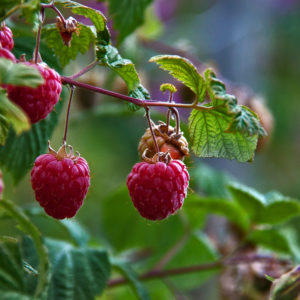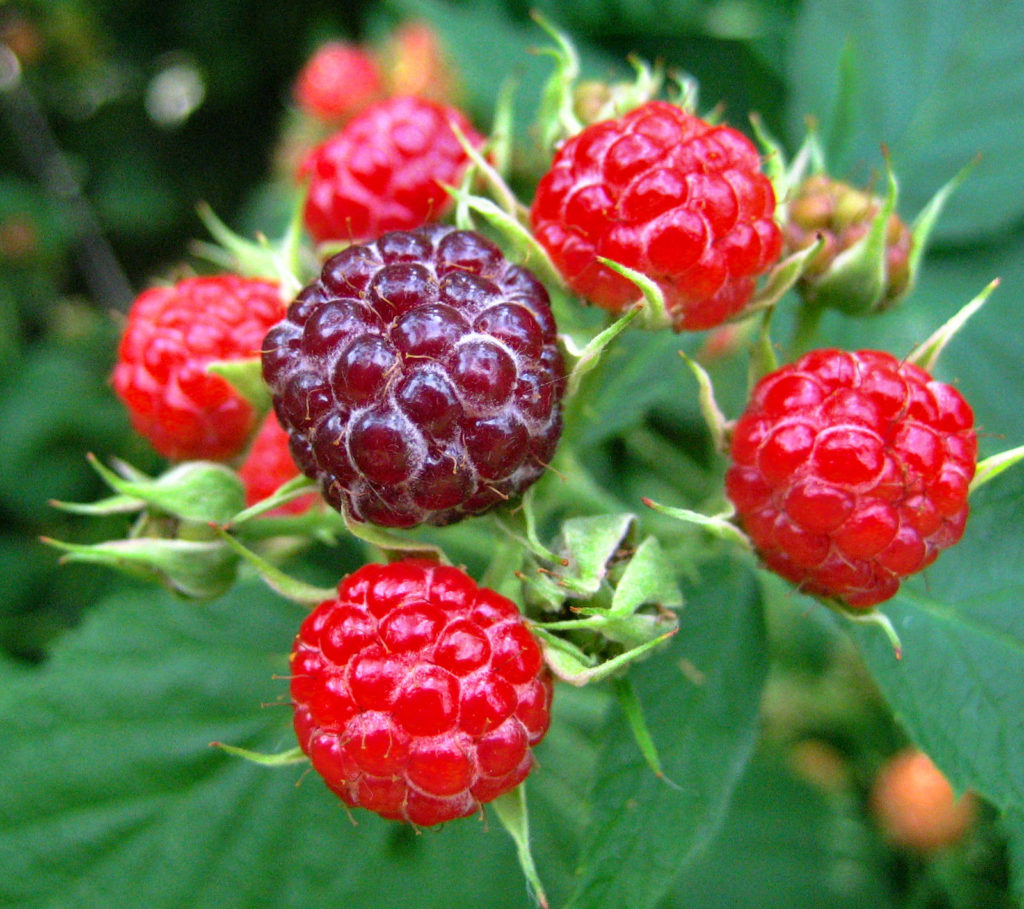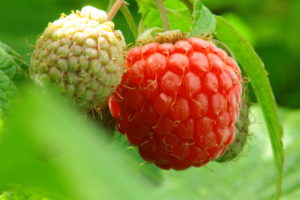Raspberries are grown worldwide. Red raspberries, Rubus idaeus, were first grown as a crop in Turkey. They spread through western Asia and eastern Europe and were cultivated throughout Europe and Asia by the late Middle Ages. Black raspberries are native to North America, Rubus occidentalis being the most common, originating in Eastern North America, and Rubus leucodermis which is native to the Pacific coastal areas. The two types of black raspberries are pretty similar and can be grown almost anywhere.
Raspberries are enjoyed raw, right off the bush, and can be used in a variety of ways. They are also used raw in smoothies or as a salad ingredient. They can be baked into muffins or pies or made into raspberry jam. Raspberry leaves are dried and used traditionally to make raspberry leaf tea, which is an herbal remedy for stomach pains or cramping and is used as an aid during pregnancy. Consult a doctor before using this tea.
Raspberries are delicious and sweet, and both main types are very similar in flavor, with black raspberries being just a bit sweeter. Both are great primary sources of Vitamin C and are good with other nutrients such as Vitamins K and E. They are a natural antioxidant and rich in fiber, as well as being low in calories!
Growing Raspberries
- Red Raspberry: Rubus idaeus
- Black Raspberry: Rubus occidentalis and Rubus leucodermis
- Perennial
- Full sun
- Soil acidity should be slightly acidic (close to 6.0 ph).
- Sandy loamy soil, fertile and well drained
- Garden spacing:
4 feet apart (48”) with rows 6 feet to 8 feet apart
- Containers:
16-18 inch pot per single plant (larger pots for multiple plants)
- Climate Zones 3-9

Planting new raspberries from canes is the easiest and most common way to grow them. As they are still dormant, these can be planted in early spring, before the last frost. Bare-root canes should be soaked for about 6 hours before planting. Space the plants about 4 feet apart. Dig a deep hole, that will allow the roots to fully branch out. It’s best to heap the soil up at the bottom of the hole and spread the roots out over that. Plant so that the roots are fully covered, leaving the full cane above the ground. Keep the plants watered, usually the equivalent of about 1 inch per week. Potted raspberries are also easy to transplant to the garden, just dig a hole a bit larger than the pot, and carefully move the plant to the garden. Wait until the temperatures are a bit warmer, well after the last frost. Purchased potted raspberries are generally not still in the dormant state.
Both black and red raspberries are divided into two types: Summer bearing raspberries and Everbearing (also called fall-bearing) raspberries. Summer bearing types grow on canes that fruit in the second year of their growth. New canes grow and mature one summer, then bear fruit the following summer. Everbearing types will grow and mature over the first summer and bear fruit in the first fall. They will also grow some new berries in the spring or early summer of the following year. Raspberries live 8 to 10 years and will grow new canes every year.
When to Prune Raspberries
Pruning is especially important for raspberries. For summer bearing raspberries, the second-year canes should be trimmed down to the ground after the berries have been harvested in the summer. This keeps the energy of the plant focused on the new growth, which is best for larger harvests over the life of the plant. For everbearing raspberries, trim the canes down to the ground during the second year also, but do this after they bear fruit for their second harvest early in the season. For both types, leave the first-year canes to go dormant over the winter for harvest the following year. Also, shoots need to be managed. New shoots or canes will sprout a short distance from the main plants. These can be carefully dug up and replanted if you would like to start a new section of raspberries. Otherwise, trim them down, they will interfere with the growth of the main bush.
For container-grown raspberries, plant a single cane into a large pot, about 18” in diameter, or larger, and at least 24” deep. This is a good option for those with smaller gardens, and they can be grown on a patio or even a balcony! A few varieties are better for containers, such as the Raspberry Shortcake raspberry, a smaller round bush that works well as a potted plant, since it doesn’t need a trellis. Several varieties can be purchased as a potted raspberry already started, as well. Water regularly, a few times a week in temperate areas, more often in drier climates. Keep them pruned the same way as garden raspberries.

There is a long list of good companion plants for raspberries. Some help with nutrients for the soil, and others help keep pests away. Grains like oats, rye, and buckwheat will help with nutrients and attract bees and other pollinators. White or red clover are also good for nutrients, especially for fixing nitrogen in the soil. Strong-smelling companions like garlic and lavender will help deter pests by hiding the pretty smell of the raspberries from common raspberry pests like Japanese beetles. Yarrow also helps to deter some pests, and it attracts ladybugs! Ladybugs are a great help with aphids and many other insect pests.
Raspberry Pests and Diseases

Typical raspberry pests include Japanese beetles and aphids, as already mentioned, as well as raspberry cane borers, raspberry beetles, leafhoppers, thrips, and mites. Preventative measures such as Neem oil spray can help with many of these. Other issues that can trouble raspberries include fungal diseases like powdery mildew, cane blight or spur blight, rust, anthracnose, and gray mold. Viral infections can also be a problem, such as a leaf curl (spread by aphids), and mosaic virus. Netting can help prevent pests that spread these infections. Neem oil is a good anti-fungal treatment. If a plant becomes fully infected with a virus or a fungus, remove the entire plant and dispose of it carefully away from the garden. Prevention is best. Using clean tools, keeping the garden bed weeded and the plants pruned, and planting companions that discourage pests, are the best steps to take in advance to prevent this kind of thing.
Raspberries do well in a wide range of climates, but need as much sun as possible, at least 6 hours per day. They do have a requirement for “chill hours” during winter months when the plants are dormant. Usually about 250 hours of temperatures between freezing and 45°F. This requirement varies a bit for each variety of raspberry, but the low number of hours required means that most areas in the United States are fine for these plants. Check the specific requirement of the variety you are planting and your local temperatures for help with this.
When to Harvest Raspberries
Harvest the raspberries by gently pulling them from the plant once they are fully ripe. Store them in small containers especially if you have a big harvest! Use them quickly, but keep them in the refrigerator for a few days if needed. The individual berries can be frozen for longer storage.
If desired, raspberries can also be grown from seed. Each berry has a lot of individual seeds, one in each little pod on the surface of the berry. The berries can be squeezed, and the seeds dry out. These can be planted in the fall, indoors, in seedling trays, then replanted in individual pots once they start to sprout. Plant the seedlings in the garden in the spring, spaced about 4 feet apart, just like cane planting, or use them for container planting. These will take longer to mature and grow into full-sized plants but if well cared for they will do great!

Contact Author
 info@gardensavvy.com
info@gardensavvy.com Recent Posts
- Smart Gardening: How Technology Is Revolutionizing Horticulture
- Understanding Gardening Zones: What You Need to Know
- The Right Tools For Your Gardening And Landscaping Needs
- Maximizing Your Harvest: Square Foot Gardening Chart for Beginners
- Holiday Garden Scents: Plants for Natural Aromatherapy in Your Home









